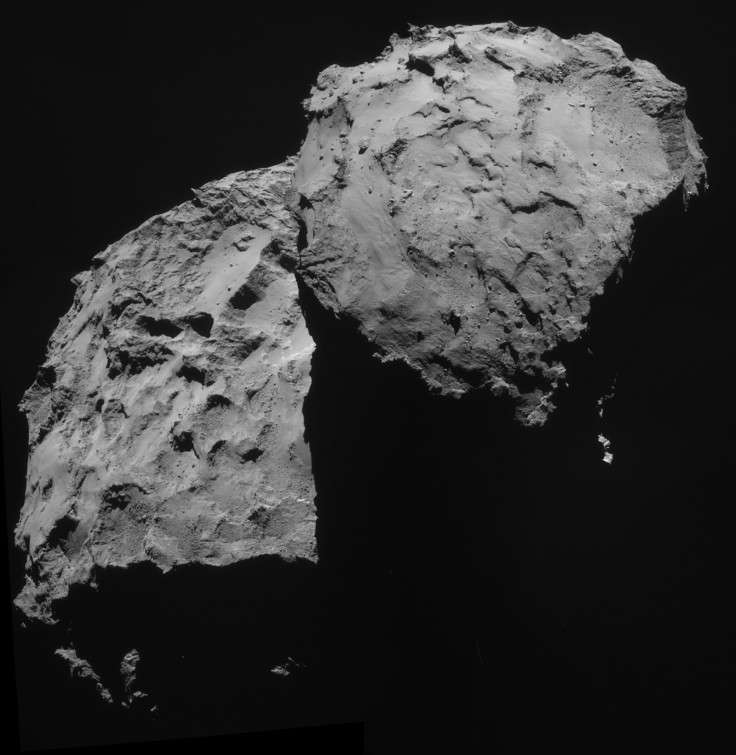Rosetta on Track Confirms ESA for Historic Moment When Probe Lands on Comet 67P

The Flight Dynamics Team at ESOC have confirmed that Rosetta and Philae are on the correct orbit and that Rosetta can achieve the delivery trajectory to deliver the lander onto the surface of comet 67P as planned.
The historic mission that will land a probe on a comet allows scientists for the first time to directly analyse the composition of a comet.
Once the 100 kg robot is let go on November 12 at 8.35 am GMT from an altitude of 20 km, it has no means of adjusting its descent and will go where the comet's low gravity pulls it.
Touchdown will be confirmed at 1600 GMT.
The washing-machine size probe is expected to touch down and fix itself to the two-mile long, high-speed comet using harpoons and drills.
It will then begin to analyse the ice, organic material and chemicals present in the comet's nucleus – and later, as it gets closer to the Sun and begins to heat up – the emissions of gases such as water and carbon dioxide.
Astronomers believe that comets like 67P may have delivered all of Earth's water after its formation, 4.5 billion years ago. Rosetta and Philae will test that theory.
The 1.3 billion euro Rosetta spacecraft was launched in 2004, and has spent a decade covering four billion miles manoeuvring for its rendezvous with ancient comet 67P/Churyumov-Gerasimenko.
Performing three flybys of the Earth, one of Mars and also passing close to two asteroids, it finally reached comet 67P on 6 August this year. It will continue to follow the comet around the Sun and as it moves back out towards the orbit of Jupiter.
Old technology
Philae could land on terrain whose constitution is anything between rock hard and puff-powder soft.
Having left earth in 2004, Rosetta and Philae rely on relatively old technology, giving rise to some concern.
But even if the landing attempt fails, the pictures and measurements of 67P acquired by the Rosetta mothership in recent weeks will be enough to re-write the textbooks.
"The real scientific value of this mission is spread all over Rosetta and its instruments, and the lander is just a part of that," ESA flight director Andrea Accomazzo told BBC.
The vast distance between the comet and the Earth - 510 million km - means radio commands take almost half-an-hour to reach the spacecraft.
Academia tense
Among the academia associated with Rosetta are Professor Alan Fitzsimmons from the Astrophysics Research Centre at Queen's University and colleagues who spent over a decade studying comet 67P/Churyumov-Gerasimenko from Earth and measuring its properties.
Professor Alan Fitzsimmons said, "We have waited over 10 years for this day, but with the comet being over 317 million miles away, all we can do now is cross our fingers and hope."
Planetary scientist Professor Stanley Cowley, of the University of Leicester's Department of Physics and Astronomy, has also worked on the planning stages of the Rosetta mission.
He said, "The Philae lander is the first attempt to land a spacecraft on the surface of a comet nucleus. The main new thing here is the ability to directly sample the surface material using a 9-inch drill, and to analyse that material using a series of experiments looking at the chemicals present."
In 1994, he proposed the original case for the inclusion of a magnetic field instrument on the Rosetta satellite, which was accepted and became the Fluxgate Magnetometer (MAG) - one of a bank of five hi-tech instruments, known as the Rosetta Plasma Consortium (RPC), onboard the satellite.
Singing Comet?
In fact one of these instruments has detected a song coming from the comet!
In the form of oscillations in the magnetic field in the comet's environment, the song is being sung at 40-50 millihertz, far below human hearing, which typically picks up sound between 20 Hz and 20 kHz.
To make the music audible to the human ear, the frequencies have been increased by a factor of about 10,000, says ESA.
The music was heard clearly by the magnetometer experiment (RPC-Mag) for the first time in August, when Rosetta drew to within 100 km of 67P/C-G. The scientists think it must be produced when the comet releases neutral particles into space where they become ionized.
The physical mechanism behind the oscillations remains a mystery.
The plasma instruments monitor the comet's interaction with the solar wind, changes of activity on the comet, the structure and dynamics of the comet's coma or atmosphere and the physical properties of the cometary nucleus and surface.
© Copyright IBTimes 2025. All rights reserved.





















